
VisionCBAImageCytometrySystem,视觉CBA图像分析仪系统
- 属性
- 详情
- 产地: 美国
- 关注度: 次
- 品牌: nexcelom
- 型号: Vision CBA Image
- 厂商性质: 生产型,
- 价格: 电议
- 添加时间: 2012/12/31
产品介绍
Cellometer Vision offers advanced primary cell analysis. The Cellometer Vision CBA includes hardware and software upgrades that enable analysis of Cell-Based Assays

- Watch Caspase-8 Video »

- Watch Apoptosis Video »

- Watch Cell Cycle Video »

- Watch Mitochondrial Video »

- Watch Hepatocyte Video »






Simple, 20µl Cell-Based Assays
Nucleated Cell Counting & Viability without Lysing
Trypan Blue Viability
Hepatocyte Analysis
Analysis of Clumpy and Irregular-Shaped Cells
Adipocyte Analysis
Yeast Viability for BioFuel Production
Exclusion of Debris & Size-Based Counting
View, Print and Save Cell Images and Data
User-Changeable Fluorescence Optics Modules
Counting Chambers - No Washing or Contamination
Dedicated On-line and On-site Support
Vision vs. Vision CBA
Vision Accessories

-
Learn More
- » Submit a Question
- » Request a Demo
- » Request a Quote
-
- » Vision CBA Brochure
- » Vision Spec. Sheet
- » Vision CBA Spec. Sheet
- » Hepatocyte App. Note
- » Cell Cycle App. Note
Simple, 20µl Cell-Based Assays
The Vision CBA System combines the simplicity of image cytometry with the power of flow analysis software to offer user-friendly cell-based assays, featuring:
- Validated assay kits and reagents
- Simple staining and analysis procedures
- Default settings for automated data generation
- No washing. No clogging. No daily calibration.
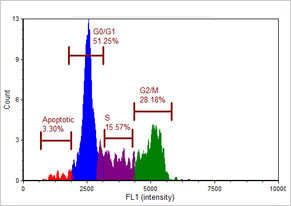
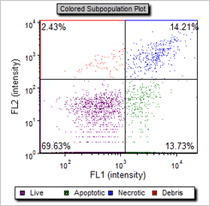
Growing Menu of Assays
| Fluorescent Cell-Based Assays |
|
Vision CBA
|
|---|---|---|
| Apoptosis (Annexin V-FITC / PI) |
|
|
| Apoptosis (Caspase Activity) |
|
|
| Autophagy (CytoID-green) |
|
|
| Cell Proliferation (CFSE) |
|
|
| Cell Cycle (PI) |
|
|
| GFP, RFP, YFP Transfection |
|
|
| Mitochondrial Potential / Early Cell Death (JC-1) |
|
|
| Multi-Drug Resistance (ABC Transporter) |
|
|
| Surface Marker Analysis (FITC) |
|
|
| Viability (AO/PI, Trypan blue) |
|
|
| Vitality (Calcein-AM / PI) |
|
|
Flow-Like Data Output
Vision CBA and FCS Express Software enable automated data output to pre-set data layouts for individual cell-based assays. Users have the option to modify the automatic gating with instant visual display and data update.
- Cell Images
- Data Tables
- Dot Plots
- Histograms
Data layouts can be modified to accommodate multi-sample analysis and create customized analysis and / or quality control reports.
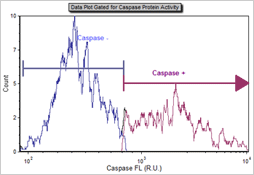
Back to top ↑
Nucleated Cell Counting and Viability in <60 Seconds
Count Live Nucleated Cells
Fluorescent dyes that stain DNA can be used to identify nucleated cells in a mixed cell population. Acridine orange (AO) is a nuclear staining (nucleic acid binding) dye permeable to both live and dead cells. It stains all nucleated cells to generate green fluorescence.
Count Dead Nucleated Cells
Fluorescent membrane-exclusion dyes that stain DNA can be used to identify dead nucleated cells in a mixed cell population. Propidiom iodide (PI) is a nuclear staining dye that can only enter cells with compromised membranes. Healthy cells exclude the dye. Dead nucleated cells stained with both AO and PI fluoresce red due to fluorescence resonance energy transfer.
Live cells stained with AO
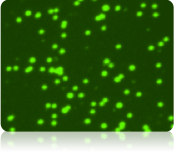
Dead cells stained with PI

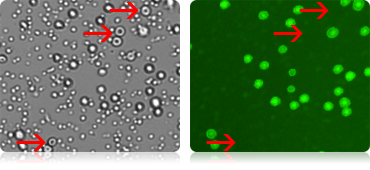
Red blood cells seen in the bright field image (red arrows, left image) are not visible in the fluorescent image on the right. Red blood cells are excluded from cell counts.
No Interference from RBCs, Platelets, or Debris
Because platelets and mature mammalian red blood cells don't contain nuclei, only mononuclear cells produce a fluorescent signal. Fluorescent-positive live and dead nucleated cells are easily counted and red blood cells are excluded from cell counts. There is no need to lyse red blood cells, saving time and eliminating an extra sample preparation step. This also allows technicians to use a single viability method for analysis of both fresh and processed blood, bone marrow, and digested tissue samples.
Back to top ↑
Trypan Blue Viability
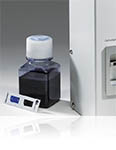
In addition to dual-fluorescence viability, the Vision includes a default assay for cell concentration and % viability for cultured cells stained with trypan blue.
Trypan blue viability is a dye exclusion method that utilizes membrane integrity to identify dead cells. The dye is unable to penetrate healthy cells, so they remain unstained. Dead cells have a compromised cell membrane that is permeable to the trypan blue dye. Dead cells are stained blue and display as dark cells in the Cellometer software with bright field imaging.
Other bright field stains, such as Methylene Blue and Erythrosine B, can also be analyzed using Cellometer cell counters.
Counted Trypan Blue Bright Field Image
Counted Erythrosin B Bright Field Image
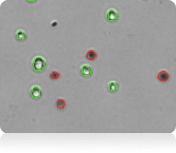
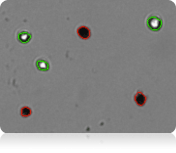
Live cells are circled in green. Dead cells are circled in red.
Within 30 seconds, the Vision instrument reports:
- Cell concentration (total, live, and dead)
- Cell number (total, live, and dead)
- Mean cell diameter (total, live, and dead)
- Percent viability
Back to top ↑
Hepatocyte Analysis
Primary hepatocytes (both fresh and cryo-preserved) are routinely used to test potential drug candidates for toxicity. Seeding with identical numbers of viable cells is important for accurate toxicity experiments. Due to their variable morphology and tendency to clump, hepatocytes can be difficult to count manually or with other automated cell counters. The Cellometer Vision features specialized algorithms for accurate counting of hepatocytes. Dual-staining with AO/PI enables counting of live and dead hepatocytes for automated viability determination.
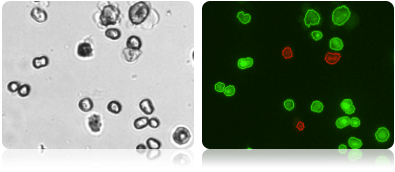
Bright field image (left) shows the variable morphology of primary hepatocytes. Dual fluorescence image (right) shows counted live cells (circled in green) and counted dead cells (circled in red).
Simple Imaging Method Ideal for Fragile Cells
Hepatocytes are quite fragile. Because the Vision images cells directly from the counting chamber, the shear stress present in flow-based systems (where cells travel through the instrument) is eliminated.
Fast Analysis for Accurate Viability Determination
Because hepatocytes lose viability over time, it is important to complete the analysis very quickly. Staining with the Cellometer AO/PI viability reagent and loading of the counting chamber takes just 1 minute. Analysis with the Cellometer Vision is completed in less than 60 seconds.
Back to top ↑
Yeast Viability for BioFuel Production with Vision 10x
The Cellometer Vision (10x) Image Cytometry System is optimized for simple, 1-step determination of yeast concentration and viability in messy samples. Fluorescent nuclear staining dyes are used to stain live and dead nucleated cells. Learn more about the AO/PI dual-fluorescence method.
The Cellometer Yeast Viability Kit was specifically developed for dual-fluorescence analysis of yeast in samples containing corn mash. Reagents for viability of yeast in samples containing corn stover, sugar cane, and biomass are also available. Contact Nexcelom technical support for more information.
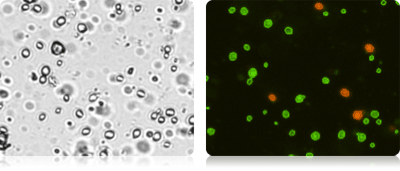
Bright field and fluorescent images of yeast from corn mash. Debris visible in the bright field image (above left) is excluded in the dual-fluorescence image (above right). Only live (circled in green) and dead (circled in red) yeast are counted.
Back to top ↑
Analysis of Clumpy and Irregular-Shaped Cells
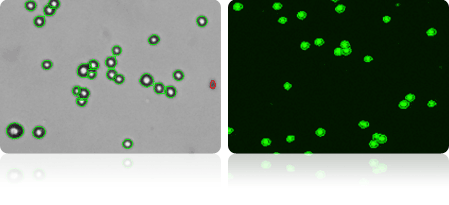
Including the NCI-60 human cancer cell lines developed by the National Cancer Institute.
Clumpy Cells
The MCF-7 breast cancer cell line can be very clumpy. The Cellometer pattern-recognition software identifies and counts individual cells within these cell clumps for accurate analysis (shown at right).
For clumpy cells with poorly-defined edges, the Vision offers fluorescent counting. Cells can be stained with a nuclear dye, such as acridine orange (AO), then imaged and counted in the fluorescent channel.
Irregular-shaped Cells
The Cellometer cell roundness setting can be adjusted for recognition and counting of irregular-shaped cells, such as RD cells, activated T-cells, and hepatocytes.
- More than 1,600 different cell lines have been successfully counted using Cellometer Systems
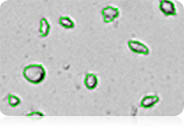
Back to top ↑
Adipocyte Analysis
Nexcelom has designed specialized (PD-300) counting chambers to accommodate large cells, including adipocytes. The controlled chamber depth eliminates potential problems caused by the buoyancy of adipocytes. Imaging directly from the counting chamber eliminates the shear stress present in flow-based systems where cells travel through the instrument, making accurate analysis of fragile adipocytes possible.
Optimized bright field counting parameters or fluorescent stains can be used to exclude free lipid droplets (shown at right) from counting results. Optimized settings for adipocyte analysis are saved as a unique cell type
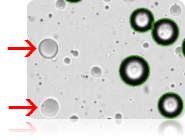
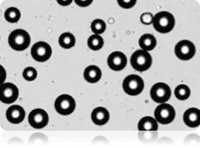
Bright field image of adipocytes
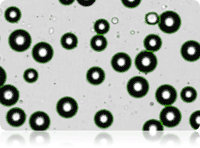
Bright field counted image of adipocytes
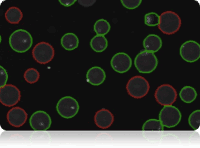
Dual fluorescence live / dead counted image of adipocytes
Back to top ↑
Exclusion of Debris & Size-Based Counting
Because Cellometer recognizes cells based on size, brightness, and morphology, cellular debris is easily and accurately excluded from counting results.
- Cell size parameters can be modified to optimize exclusion of debris from results and enhance the accuracy of counting for a wide range of cell sizes.
- A fluorescent nuclear dye, such as acridine orange, can be used to more easily identify nucleated cells in samples containing debris.

Cell Size Histogram
The Cellometer Vision automatically generates a cell size histogram based on cell diameter.
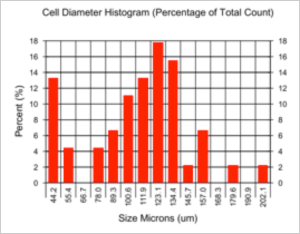
Adipocyte cell size histogram showing variation in cell diameter from 44 to 202 microns.
Size-Based Counting
Minimum and maximum cell diameter settings in the Cellometer software can be optimized to count specific cells in a sample. The example below demonstrates counting of mature dendritic cells cultured from PBMCs based on cell diameter.
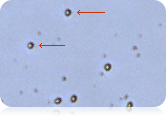
Back to top ↑
View, Print, and Save Cell Images and Data Tables

Bright field and fluorescent counted images of macrophages stained with Calcein-AM for detection of metabolically-active cells. Debris and dead cells in the bright field image (left) are not visible in the fluorescent image (right).
View Bright Field Images to check cell morphology.
View Fluorescent Counted Images to:- confirm exclusion of debris
- confirm exclusion of unwanted cell types
- optimize counting of irregular-shaped cells
- confirm counting of individual cells within clumps
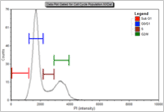
Automatically Save raw images and data to a secure network location.

Export Data to Excel.
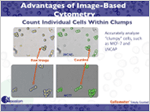
Capture Colorized Images with screen-capture software for use in publications and presentations.

Print images and custom data reports directly from Cellometer software and FCS Express.
Back to top ↑
User-Changeable Fluorescence Optics Modules
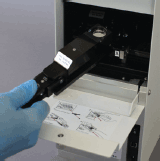

| Optics Module | Fluorophores | Nucleic Acid Stains | Fluorescent Proteins |
|---|---|---|---|
| VB-450-302 Ex: 375 nm Em: 450 nm |
AlexaFluor® 350 | DAPI Hoechst 33342 Hoechst 33258 |
BFP CFP |
| VB-535-402 Ex: 475 nm Em: 535 nm |
Calcein FITC AlexaFluor® 488 |
AO (acridine orange, +DNA) SYTO®9, SYTO®13 |
GFP YFP |
| VB-595-502 Ex: 525 nm Em: 595 nm |
AlexaFluor® 546 AlexaFluor® 555, Cy3® PE (R-phycoerythrin) Rhodamine B |
PI (propidium iodide) EB (ethidium bromide) SYTOX® Orange |
57.5 |
| VB-660-502 Ex: 540 nm Em: 660 nm |
AlexaFluor® 647 7-AAD Nile Red |
PI (propidium iodide) EB (ethidium bromide) AO (acridine orange, +RNA) |
Ds Red RFP TdTomato |
| VB-695-602 Ex: 630 nm Em: 695 nm |
AlexaFluor® 647, Cy5® APC (allophycocyanin) |
SYTOX® Red | Crimson |
*This table is a partial list of compatible fluorophores, nucleic acid stains, and fluorescent proteins. Please contact Nexcelom technical support regarding compatibility of other reagents.
Sytox, AlexaFluor, and Cy are trademarks of Life Technologies.
Back to top ↑
Counting Chambers: No Washing or Contamination
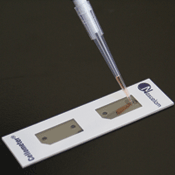
Cellometer Disposable Counting Chambers consist of two independent enclosed chambers with a precisely controlled height. Cell suspension of 20 microliters is loaded into the chamber using a standard single channel pipette.
The chamber is inserted into the Cellometer cell counter and the cells are imaged directly from the chamber. This simple sample loading and analysis method is ideal for fragile cells.
The disposable Cellometer Cell Counting Chambers offer several key advantages:
- Time savings – no washing
- No risk of cross-contamination
- Reduced biohazard risk to users
- Controlled sample volume
- Controlled chamber depth
- Direct imaging from chamber
- Most affordable automated counting consumables
Back to top ↑
Dedicated On-line and On-site Applications Support
On-site demonstrations allow users to evaluate a critical cell type or cell-based assay prior to making a purchase.
Technical seminars are a great way to introduce Cellometer cell viability and cell-based assays to multiple users within a lab or organization.
Free on-site installation and training are available to all Vision and Vision CBA customers.
Web-based support sessions are available to all Cellometer customers at no cost. Nexcelom technical support specialists can assist with creation of new cell types, optimization of counting parameters, and analysis of cell-based assays.
Comprehensive Protocols for a growing menu of cell-based assays assist with sample preparation, imaging, and data analysis. Detailed, step-by-step instructions with screen shots enable new users to run Cellometer kits for cell cycle, apoptosis, cell viability, and other assays.
On-Line Help can be accessed directly from the Vision and Vision CBA Instruments. Users can:
- View training videos
- View frequently asked questions
- Download instructions and software updates
- Submit a Support Ticket directly to Nexcelom
Cellometer Vision vs. Vision CBA: Which System is Right for Me?
| Application or Cell-Based Assay |
Vision
|
Vision CBA
|
|---|---|---|
| Live/Dead Cell Concentration & Trypan Blue Viability (clean cell samples) |
X
|
X
|
| Live/Dead Nucleated Cell Concentration & Dual-Fluorescence Viability (samples with and without debris, RBC, platelets; no lysing) |
X
|
X
|
| Small Cells: Yeast, Algae, Platelets |
10x
|
10x
|
| Hepatocyte and Adipocyte Analysis |
X
|
X
|
| Cell Cycle: PI |
|
X
|
| Apoptosis: Annexin V-FITC/PI, Caspases, Mitochondrial Membrane Potential |
X
|
X
|
| Autophagy |
X
|
X
|
| GFP, RFP, YFP, and other fluorescent proteins* |
X
|
X
|
| Surface Markers: FITC*, PE*, APC* |
|
X
|
| Proliferation: CFSE* |
|
X
|
| Apoptosis: Chromatin Condensation* |
|
X
|
X = numbers only X = with population plots and histograms
*Enhanced sensitivity of Vision CBA is strongly recommended for this application
*Enhanced sensitivity of Vision CBA may be required if signal is weak
Back to top ↑
Cellometer Vision Accessories
Cellometer Vision / Vision CBA Fluorescence Optics Modules
User-changeable fluorescence optics modules compatible with the Cellometer Vision and Vision CBA Systems
| Catalog # | Description | Compatible Dyes / Fluorophores* | Unit |
|---|---|---|---|
| VB-450-302 | Cellometer Vision Optical Module Excitation / Emission: 375nm/450nm |
DAPI, Hoechst 33342 and 33258, BFP, CFP | each |
| VB-535-402 | Cellometer Vision Optical Module Excitation / Emission: 475nm/535nm |
Acridine Orange (AO) (+DNA), Fluorescein (FITC), SYTO®9, SYTO®13, Calcein, Fluorescein (FITC), AlexaFluor®488, GFP, YFP | each |
| VB-595-502 | Cellometer Vision Optical Module Excitation / Emission: 525nm/595nm |
Propidium Iodide (PI),Ethidium Bromide (EB), SYTOX® Orange, AlexaFluor®546, AlexaFluor®555, Cy3®, R-phycoerythrin (PE), Rhodamine B, Ds Red, RFP, TdTomato | each |
| VB-660-502 | Cellometer Vision Optical Module Excitation / Emission: 540nm/660nm |
Propidium Iodide (PI),Ethidium Bromide (EB), Acridine Orange (AO) (+RNA), AlexaFluor®647, 7-AAD, Nile Red | each |
| VB-695-602 | Cellometer Vision Optical Module Excitation / Emission: 630nm/695nm |
Allophycocyanin (APC), AlexaFluor®647, Cy5®, SYTOX® Red, Crimson | each |
Software
Software upgrades available for the Cellometer Vision CBA Instrument
| Catalog # | Description | Size | Unit |
|---|---|---|---|
| VSL-01 | Cellometer Vision Software License for GMP/GLP Support | Single-user copy | 1 license |
| FCS-SW4RP-10 | Additional single-user copy of FCS Express 4 Flow, RUO Professional Software | Single-user copy | 1 license |
IQ / OQ Validation Package
Installation Qualification (IQ) and Operational Qualification (OQ) package for the Vision instrument.
| Service | Description | Size | Unit |
|---|---|---|---|
| Cellometer Vision-IQOQ | Counting chambers, reference bead solution, and IQ/OQ validation protocol for the Cellometer Vision | 100 counts | 1 Set |
On-Site Service, Maintenance, and Instrument Warranties
Trained Nexcelom Applications Specialists are available for on-site preventative maintenance, IQ validation, and OQ validation.
| Service | Description |
|---|---|
| Preventative Maintenance |
Available for all Cellometer Systems Please inquire for scheduling and pricing. |
| IQ Validation* |
Available for Auto T4, Auto X4, and Vision Systems Please inquire for scheduling and pricing. |
| OQ Validation* |
Available for Auto T4, Auto X4, and Vision Systems Please inquire for scheduling and pricing. |
| Extended Warranty |
Available for all Cellometer Systems currently under a valid warranty. Please inquire for pricing. |
Models and Specifications
| Cellometer Vision CBA | |||||||||||||||||||||||||||||||||
|---|---|---|---|---|---|---|---|---|---|---|---|---|---|---|---|---|---|---|---|---|---|---|---|---|---|---|---|---|---|---|---|---|---|
Includes: |
· Cellometer Vision HSL Instrument · PC Laptop · Two Standard Fluorescence Optics Modules · Cellometer Vision CBA Software (2 copies: 1 for instrument, 1 for remote work station) · USB 2.0 Connection Cable · Power Supply · Phone/online applications support during set-up · 75 slides |
||||||||||||||||||||||||||||||||
Optional Components /
|
10x Magnification (5x magnification is standard) | ||||||||||||||||||||||||||||||||
Imaging Performance: |
Cell Size: Conc. Range: |
Vision 5x 5 - 300* microns 105 - 107 cells/ml |
Vision 10x 0.5 - 25 microns 105 - 107 cells/ml |
||||||||||||||||||||||||||||||
| *Cellometer CHT4-PD300 Slides are required for cells > 80 microns in diameter | |||||||||||||||||||||||||||||||||
Instrument
|
Weight: 25 lbs. (11 kg) Dimensions: Width: 6" (15cm) Depth: 8.5" (22cm) Height: 14" (36cm) Voltage: 100-240V AC 50-60 Hz |
||||||||||||||||||||||||||||||||
Available Fluorescence Optics Modules: |
|
||||||||||||||||||||||||||||||||
- 公司简介
-
 来宝会员
来宝会员
一家集进口科研仪器代理销售以及实验技术服务于一体的高新技术公司。专注生物力学和3D生物打印国际前沿科研设备代理销售及科研实验项目合作服务,内容涵盖了血管力学生物学、…... 了解更多>>